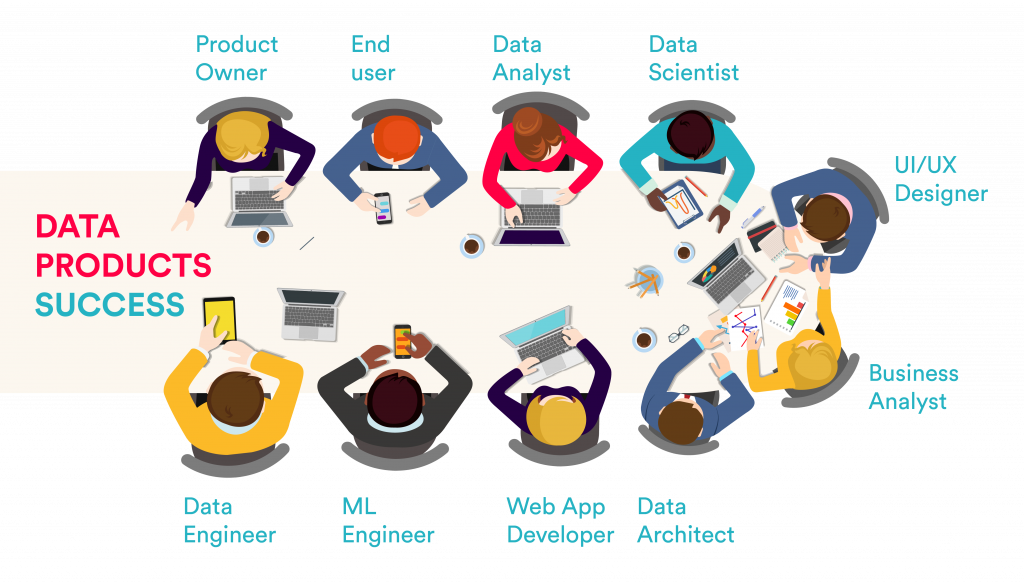Based on our market observations and our ongoing projects, a pretty obvious vision for the future is emerging: we will no more strictly distinguish between BI and AI units but rather we will unite and merge the initiatives and speak of the unit for the provision of data products. We have already initiated this journey together with a few data-driven companies. But let’s take a step back and start with the most important question: what are “data products”?
What are data products?
Broadly speaking, data products comprise everything that generates added value from raw data. This definition is very broad and there are many different types of them. Especially the detailed methods for the development of a data product can vary a lot. The analytical methods used for further processing and refining of the raw data can range from alleged simple visualizations to advanced AI algorithms. Even within AI algorithms we can use NLU or computer vision techniques for example.
Broadly speaking, data products comprise everything that generates added value from raw data.
And for the end user, it just doesn’t matter. It’s not necessary to differentiate between those from the perspective of the user. It needs to address their questions that can be answered with data and that’s it. And the process to generate a data product is broadly speaking the same for all analytical methods. But the methods for the deployment can range as well again. The presentation of a data product can have the face of a simple alert via email, a dashboard or an elaborate web app with extensive previous UI/UX processes. The methods of making the data product available to the end user also only have to serve one goal: to address business problems that can be solved by a data product.
This leads us to an important and less obvious part of the definition of data products: we defined it as everything that generates added value from raw data. This requires for all data products a proper business understanding, process analysis and a mapped data understanding which can only be done in an interdisciplinary style between business and IT. And this necessary foundation, especially the data and skills used for these purposes, can be used for both, either BI or AI use cases. The biggest challenge in any data project is the steady focus on business value.
And this raises the next question: what do we need to deliver data products successfully?
Keys to success
In order to successfully deliver data products we need to organize and orchestrate the following pillars:
- Organization & Roles
- Data Literacy & Training
- Data Governance & Security
- Infrastructure & Data
Organization & Roles
A proper organization, especially for the central deployment of data products, is key. This unit is located between business and IT and works as an interdisciplinary team. The following roles are optimally covered by the team and should be put around the table:

People around the table: Product Owner, End User, Data Analyst, Data Scientist, UX/UI Designer, Business Analyst, Data Architect, Web App Developer, ML Engineer and Data Engineer.
In contrast to deployment, product development can be organized centrally or decentrally. If it is organized decentrally, it is closer to the business. In that case, data analysts and data scientists are within one business unit and use the central data product unit as center of competence and support for efficient development. There is no one size fits all solution or recommendation on the organization and individual assessment is needed.
Data Literacy & Training
In the case of a decentral development and on the way to a data-driven company, we need trainings and data literacy inside all business units. Data literacy comprises the competency to handle data and data products. Every employee needs to be aware of these and what they can deliver for them. By data literacy and training of all roles within a company, we create more ideas and use cases for data products and therefore make more use of data where it’s needed in a bottom-up approach.
Data Governance & Security
Besides data literacy and the widespread know-how about data products we need proper data governance and security concepts. If we enhance the use of data and the development and deployment of data products we need to assure data security and ethics. Moreover, we need to assure a well monitored product lifecycle management.
Infrastructure & Data
Up to this point we were talking a lot about everything else but the most important ingredient: data. The reason for that is that we want to emphasize everything else besides data which is often forgotten or not handled with enough care. But of course all these roles, skills and governance aspects are worthless without data. The data needs to be available in a high quality and not stored in silos. For that, central platforms and tools need to be put in place and can be used either for BI dashboards or for AI algorithms. More and more vendors are connecting these aspects as well and provide extensive platforms for the development and deployment of all kind of data products.
Leverage the power of BI and AI together
To sum up, we conclude that it will no more matter whether there is an AI-algorithm under the hood of a data product or a data visualization. Both create added business value and the methodologies, skills and infrastructure needed for them are very much comparable and related. Especially if it comes to the successful operationalization of any kind of data product, a centralized unit and platform has its advantages. The whole infrastructure needed can be used by both, BI and AI. And that’s why we more and more recommend to join forces of both initiatives and think as a global team.









